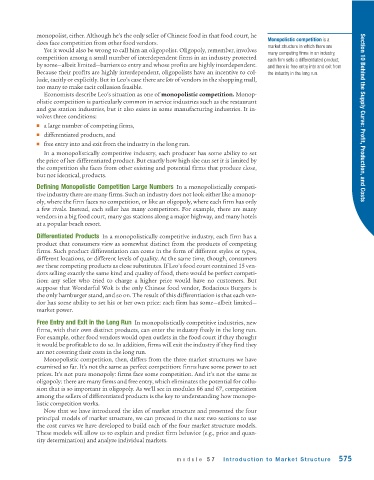Page 617 - Krugmans Economics for AP Text Book_Neat
P. 617
monopolist, either. Although he’s the only seller of Chinese food in that food court, he
Monopolistic competition is a
does face competition from other food vendors.
market structure in which there are
Yet it would also be wrong to call him an oligopolist. Oligopoly, remember, involves
many competing firms in an industry,
competition among a small number of interdependent firms in an industry protected each firm sells a differentiated product,
by some—albeit limited—barriers to entry and whose profits are highly interdependent. and there is free entry into and exit from
Because their profits are highly interdependent, oligopolists have an incentive to col- the industry in the long run.
lude, tacitly or explicitly. But in Leo’s case there are lots of vendors in the shopping mall,
too many to make tacit collusion feasible.
Economists describe Leo’s situation as one of monopolistic competition. Monop-
olistic competition is particularly common in service industries such as the restaurant
and gas station industries, but it also exists in some manufacturing industries. It in-
volves three conditions: Section 10 Behind the Supply Curve: Profit, Production, and Costs
■ a large number of competing firms,
■ differentiated products, and
■ free entry into and exit from the industry in the long run.
In a monopolistically competitive industry, each producer has some ability to set
the price of her differentiated product. But exactly how high she can set it is limited by
the competition she faces from other existing and potential firms that produce close,
but not identical, products.
Defining Monopolistic Competition Large Numbers In a monopolistically competi-
tive industry there are many firms. Such an industry does not look either like a monop-
oly, where the firm faces no competition, or like an oligopoly, where each firm has only
a few rivals. Instead, each seller has many competitors. For example, there are many
vendors in a big food court, many gas stations along a major highway, and many hotels
at a popular beach resort.
Differentiated Products In a monopolistically competitive industry, each firm has a
product that consumers view as somewhat distinct from the products of competing
firms. Such product differentiation can come in the form of different styles or types,
different locations, or different levels of quality. At the same time, though, consumers
see these competing products as close substitutes. If Leo’s food court contained 15 ven-
dors selling exactly the same kind and quality of food, there would be perfect competi-
tion: any seller who tried to charge a higher price would have no customers. But
suppose that Wonderful Wok is the only Chinese food vendor, Bodacious Burgers is
the only hamburger stand, and so on. The result of this differentiation is that each ven-
dor has some ability to set his or her own price: each firm has some—albeit limited—
market power.
Free Entry and Exit in the Long Run In monopolistically competitive industries, new
firms, with their own distinct products, can enter the industry freely in the long run.
For example, other food vendors would open outlets in the food court if they thought
it would be profitable to do so. In addition, firms will exit the industry if they find they
are not covering their costs in the long run.
Monopolistic competition, then, differs from the three market structures we have
examined so far. It’s not the same as perfect competition: firms have some power to set
prices. It’s not pure monopoly: firms face some competition. And it’s not the same as
oligopoly: there are many firms and free entry, which eliminates the potential for collu-
sion that is so important in oligopoly. As we’ll see in modules 66 and 67, competition
among the sellers of differentiated products is the key to understanding how monopo-
listic competition works.
Now that we have introduced the idea of market structure and presented the four
principal models of market structure, we can proceed in the next two sections to use
the cost curves we have developed to build each of the four market structure models.
These models will allow us to explain and predict firm behavior (e.g., price and quan-
tity determination) and analyze individual markets.
module 57 Introduction to Market Structure 575

